Interviews with the Fishermen
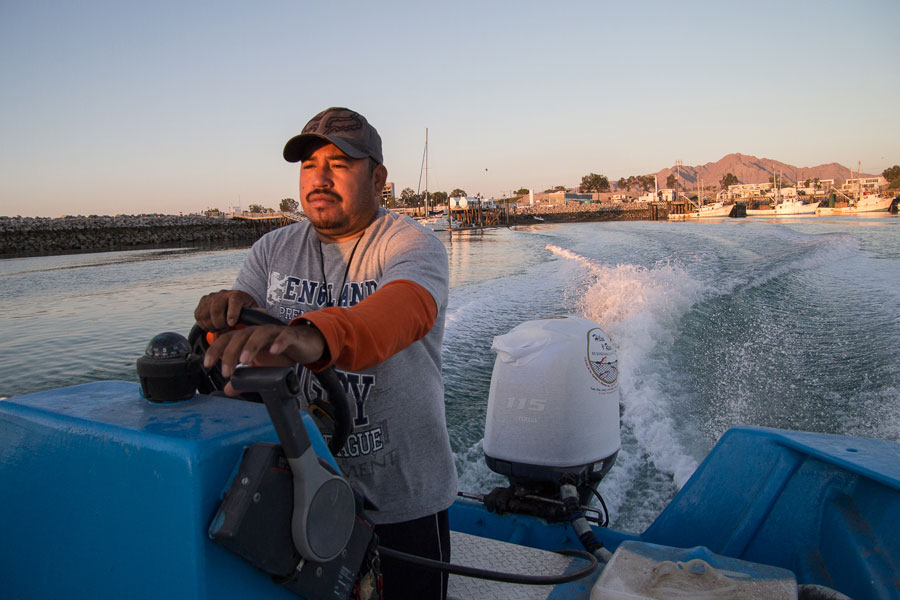
Fishing: a living and a lifestyle
José Luis “Chalunga” Romero González: I fish because I like it, because it’s the only thing I know how to do. It’s what I have done all my life. And because my father was a fisherman and sometimes you follow the tradition.
Antonio “Tonicho” García Orozco: The economic situation motivates me to fish. I have to work. Another motivator is that I love my job. I work as a fisherman and I also construct alternative fishing nets. I have been making nets for 35 years. Half of my income comes from fishing and the other half from building nets.
Javier “Chino” Valverde Márquez: My father was a fisherman and fishing was very nice at that time. It was beautiful! It is our lives! We are accustomed to it. That is why for us it is difficult to do anything else. In all this time I have never stopped fishing. Although I did other things, I always also fished. It is hard work. Often it is very cold and windy.
Armando “Muelas” Castro Soto: My motivation is that I like to fish. All of my family are fishermen and that is what motivates me to fish. It is also my only source of income, so that motivates me as well.
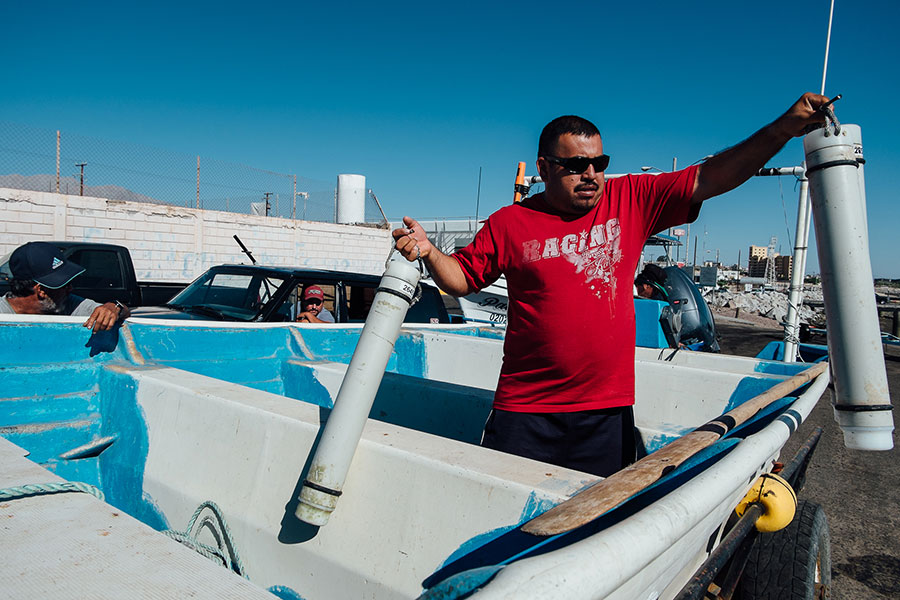
Armando “Muelas” Castro prepares the acoustic detectors, called CPODs, for deployment throughout the vaquita’s range. The CPODs record the nearly continuous clicks vaquitas make when they are searching for food in the murky waters of the northern Gulf of California. They are a powerful new tool that helps scientists to better estimate trends in the population over time by listening to the vaquitas’ sounds. Credit: Alex Espinosa
The fishermen and the sea: observers and stewards of the rich biodiversity in the Gulf of California
José Luis “Chalunga” Romero González: Once I saw Cuban (giant) manta rays flying at the surface and whales breaching! Twenty years ago the Cubans (giant manta rays) were bigger than the pangas! I haven’t seen them that big in a while. I think it is due to the gillnets—the ones they use for shark and totoaba. Gillnets are destroying everything!
Rafael “Gordis” Sánchez Gastélum: The people from San Diego [sportfishing] see the news and ask me about the vaquita. When they come here and we go on the boat and we see whales and dolphins they get excited and take pictures and I get excited too. Yes, as a fisherman, I also get excited.
Javier “Chino” Valverde Márquez: Before fishing for totoaba was illegal, we would catch them with hand lines. In two or three hours we would catch a ton of fish.
Armando “Muelas” Castro Soto: I sometimes see schools of fish that light up the water. They appear out of nowhere and surprise you! It causes an adrenaline rush!
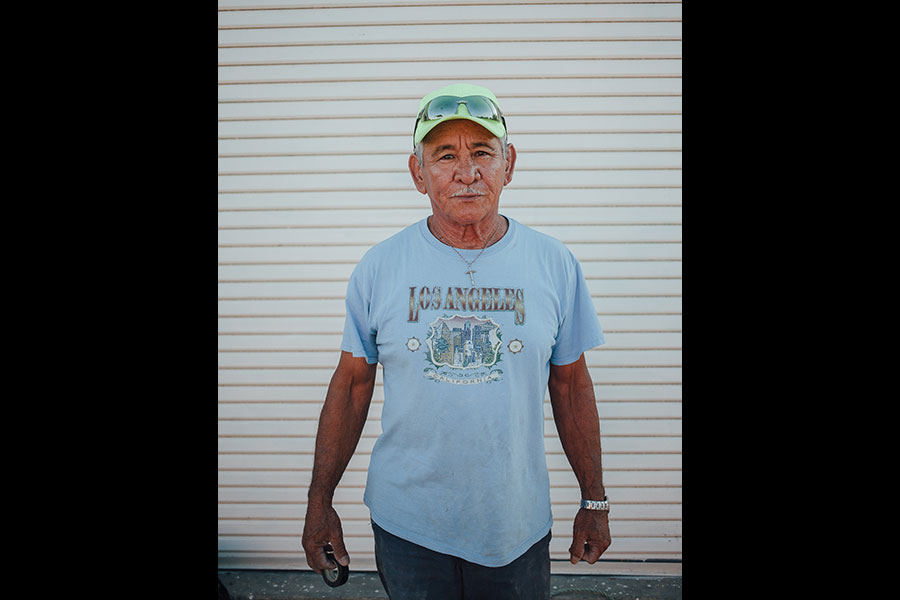
Javier “Chino” Valverde is a spiritual and active fisherman with fifty-five years of experience. He is very aware of the health of the natural environment and is often seen picking up trash and making efforts to collect plastic, which can be harmful to animals in the ocean. Credit: Alex Espinosa
Leaders among fishermen
José Luis “Chalunga” Romero González: I inspire others to use the lightweight trawls [a non-entangling fishing gear]. The other fishermen ask me about how to use them because I am a pioneer and I am good at using them. I caught a ton of shrimp in one trip a few years ago. Sharing knowledge is important. I have collaborated with other conservation organizations many times to learn more. Working together we get good results.
Antonio “Tonicho” García Orozco: What inspires me most in fishing is that we have worked hard to use sustainable nets, and we have motivated other fishermen. We have had problems and we have endured a lot from pessimistic people. We sometimes feel bad [about the pressure from other fishermen and communities that don’t want to use the alternative gear], but we have to keep working and fighting hard for this. We want to continue moving forward with the alternative fishing practices. Everything is good if we are fishing sustainably, which means, for me, respecting the rules, and it means ensuring that our product is premium quality, while taking good care of the environment by using this alternative fishing gear.
I give the other fishermen a lot of confidence because people trust in my advice. I want them to be knowledgeable in order to benefit the sector and the sustainable fishing industry.
I have worked with government and non-governmental agencies and gear design experts. For example, I am a net builder for Mexico’s National Institute of Fishing. I worked with the designers who were the first to build and use Turtle Excluder Devices (TEDs) here in San Felipe. We took courses to learn how to use them.
Javier “Chino” Valverde Márquez: I am an inspiration for the whole mancha [Ed. note: “Mancha” literally means school, like a school of fish, but it is intended here to mean a group of fishermen]. I am healthy. My knees don’t hurt. I work hard. I am active for a person of my age. Thanks to God, at my age, I go on with the mancha. They have faith in me. Like right now, we are working on the acoustic monitoring of the vaquita. We get along well.
Jesús Carlos “Charlie” Samudio Martínez: I want to be an inspiration. I want people to look at me and see that I am doing well even though I made the change [to the alternative gear]. I would like to do good things for this project because my son, who is also a fisherman, often mimics what I do.
Armando “Muelas” Castro Soto: Everybody that fishes knows their stuff. You really have to know a lot, like coordinates and how to use a GPS (global positioning system). You can’t just jump into a panga and fish. Some people use the mountains [to navigate], but when it’s foggy that doesn’t work well.
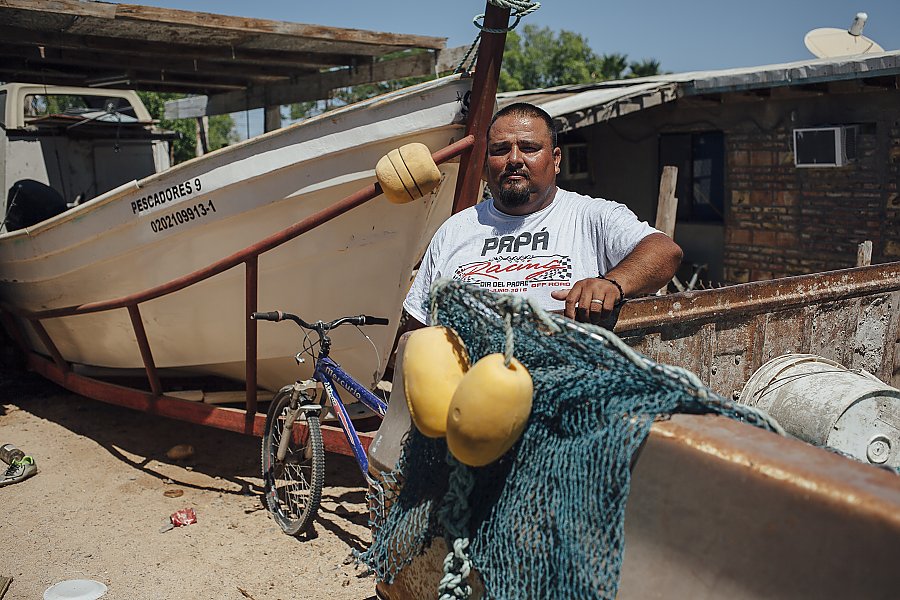
The fishermen and the vaquita
Rafael “Gordis” Sánchez Gastélum: The most amazing thing I have seen in the ocean is the vaquita. I have seen it several times. Even last year [2015] I saw it.
I have been working with Mexico’s National Institute of Ecology and Climate Change (INECC) since they started working in the upper Gulf of California. I was one of the first fishermen to help monitor the vaquita with acoustics. In the past I have seen two, three, and even four [vaquitas] together. Last year we saw only one. The first time I saw one was in 2008 or 2009. I didn’t believe they existed, but someone told me they do. One time when I was captaining the boat, a vaquita came out of nowhere. I turned the engine off and after ten minutes it came really close to us. When people question whether there are vaquita, I always say there are!
José Luis “Chalunga” Romero González: I have seen several vaquitas! It is a very skittish animal. Any little noise it hears and it’s gone and you won’t see it again. Its little fin is different than a dolphin’s, and its little head is known because it doesn’t have a snout. Its eyes look like clown eyes. I saw them near El Golfo de Santa Clara, near a shrimp farm. I saw one with its calf last November [2015].
The vaquita has the right to live as well. If we don’t save them then our grandchildren won’t know them. I want them to be able to go fishing and see one and say, “Look, there is a vaquita like my tata (grandfather) used to see!”
Just as the vaquita can go extinct, so can other species. This is a Mexican species that you can’t find anywhere else in the world. Totoaba, sea turtles, and sharks are species that there used to be a lot of, and now you only see a few.
The vaquita is not dying because of natural causes. The illegal fishermen are killing it. The ones that are fishing totoaba. And what does the government do? …
Javier “Chino” Valverde Márquez: If the vaquita goes extinct it would hurt to know that I would never see them again. I don’t know what the government would do, what actions the government would take if the vaquita were gone.
Jesús Carlos “Charlie” Samudio Martínez: I hope that [the vaquita’s extinction] doesn’t happen because it would be a shame for Mexico to lose the species. I can tell you with knowledge that their numbers are going down. And if it continues this way, tomorrow the vaquita is going to be extinct and it will be a shame. If it goes extinct I will continue to use the alternative fishing practices. I will continue to take the same position I took in 2008, and I won’t regress in order to make one or two people happy, those powerful people who don’t care about protecting our seas and our future generations. Instead they work illegally to make money.
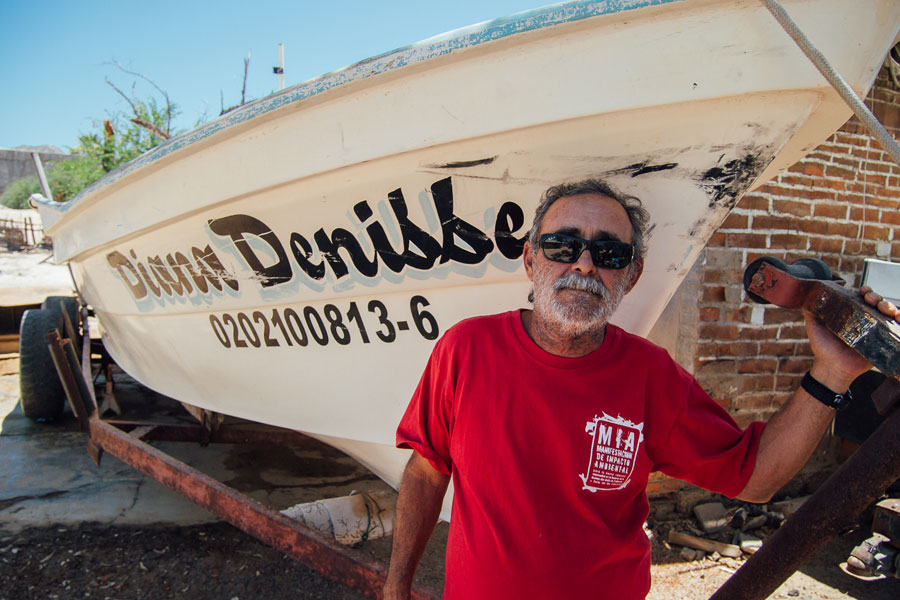
Credit: Alex Espinosa
Progress is not without its challenges
José Luis “Chalunga” Romero González: People who don’t believe in the vaquita are listened to [by the government], and the ones who believe they exist and want to try to save them are getting a kick in the butt. Still, I don’t have any regrets.
Antonio “Tonicho” García Orozco: It is important to keep relationships strong. I try to keep my friends out of violence. Those that are now enemies later will be our friends. We have to follow the path that the government has planned for alternative nets. At the end of the day, we aren’t the ones to decide things, the government is.
People are lacking technological capacity and people don’t have the will to change the future of fishing. We need to keep working hard.
Rafael “Gordis” Sánchez Gastélum: When we work with the lightweight trawls for shrimp and see gillnets in our way, we have to stop working because the trawl will get entangled in the gillnet. They can’t work together in the same space. It’s a challenge not being able to work because of the presence of the gillnets that are killing the vaquita and other endangered species.
Jesús Carlos “Charlie” Samudio Martínez: Since I converted my permit I have learned firstly to tolerate people that tell me that I am at fault for these changes [the gillnet ban] in the Upper Gulf because I accepted the transition from gillnets to lightweight trawls. People can be very aggressive about this.
[Additionally], alternative fishing practices are good, but only when used at the right times and locations.
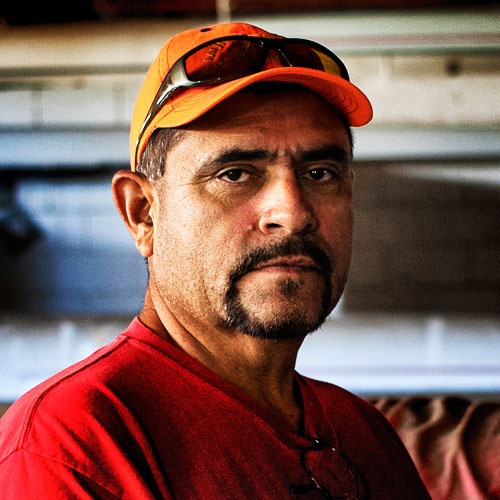
Antonio García Orozco, or Tonicho, has been fishing for 28 years. He is one of the two local experts who design and manufacture the small, lightweight shrimp trawl gear. Credit: Alex Espinosa
The future of fishing in the Upper Gulf of California
Antonio “Tonicho” García Orozco: I want to take care of the environment for the future generations. If the vaquita goes extinct it would be catastrophic. I feel like the fishing sector would lose trust in the authorities and would lose confidence in themselves.
Rafael “Gordis” Sánchez Gastélum: We harvest seafood by using vaquita-friendly practices and our products are of very fresh quality. Vaquita-friendly seafood is seafood you can buy knowing it doesn’t put the vaquita at risk. It’s a concept that I have passed on to my family. I care about the vaquita because it is endangered; it isn’t because I have seen it personally.
I am willing to keep trying new sustainable alternatives even if the vaquita goes extinct. I will inspire others to work and unite with me, telling them that this is for the good of all of us. It is for our own good to keep working hard.
Javier “Chino” Valverde Márquez: In our fishing cooperative, Islas del Golfo Cooperative, we want to provide maritime services such as eco-tourism and tours to see the vaquita. Another gift of the vaquita is that now we don’t use gillnets that hurt the ocean. I hope that the public looks at our association’s plan to get funds to protect the animals, clean the beaches and the boardwalk, to go to the islands to collect plastic bags and other trash to preserve the environment. That is the nicest thing that we could pass onto our kids—to come see the ocean and the whales.
Jesús Carlos “Charlie” Samudio Martínez: The Islas del Golfo Cooperative that I am president of stands out because we stopped using the gear that is economically profitable and started to use the lightweight trawls and traps to help the vaquita.
I believe in the changes. I work with the conservation organizations because if there are people that support you and carry out your beliefs then I am thankful for that. I support people that have the same beliefs as me, as well.
Armando “Muelas” Castro Soto: I collaborate with environmental groups because of how things are now. We want a sustainable fishery. We want to invent another type of fishing art that can work. That is why I cooperate with them. We don’t want to use gillnets anymore. We want permits for traps or permits for the lightweight trawls. Something sustainable.
I never worked with traps before so I learned how to. And I learned how to use the lightweight trawls with Antonio Garcia (Tonicho), and we learned how to make some nets that don’t trap vaquita.
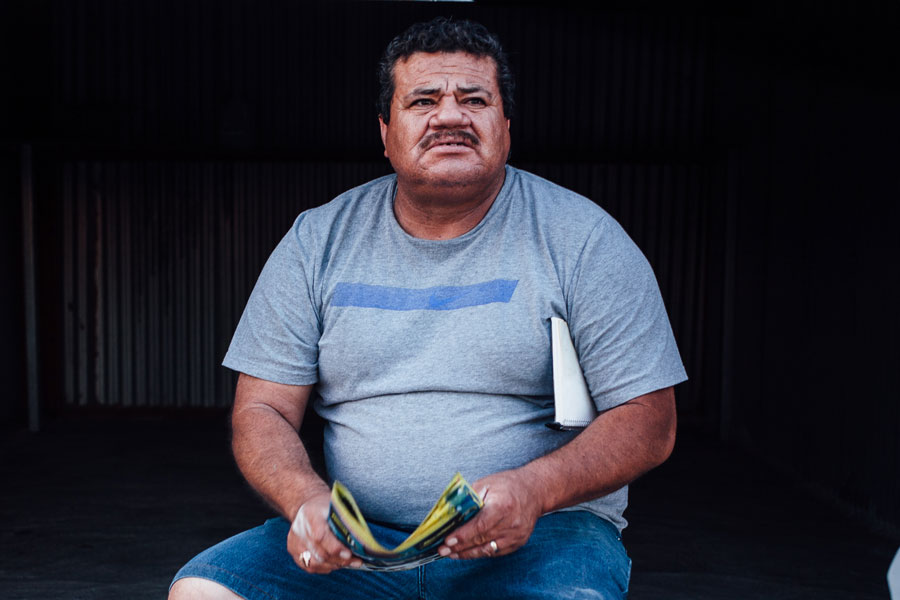
Carlos “Charlie” Samudio is the president of a local fishing cooperative. The father of two young fishermen, he concerns himself with the future of seafood for the next generation. Charlie is an amiable man and works hard at unifying the fishing community. Credit: Alex Espinosa
The fisherman’s message to the public
Rafael “Gordis” Sánchez Gastélum: I support traps and lightweight trawls. I would like the public to know that we are fishing with gear that is not harming the vaquita.
Armando “Muelas” Castro Soto: People should support us in opening the fishery again [for alternative gear only] so we can work and fish. There are a lot of people doing illegal things, it is true. But that affects the other 80 percent of us that are suffering from the closure. They should look at the volume of the families that are suffering because of this, not just the bad things a few of them are doing. A lot of people from Mexico and other regions are going to stop eating shrimp because of a few illegal fishermen. The potential embargo that people are talking about as a consequence for not fishing in a responsible way could be applied to all of Mexico for shrimp and, I think, even for fish, too.
Jesús Carlos “Charlie” Samudio Martínez: I want the world to know that people here have interest in protecting vaquitas, sea turtles, and totoaba. There are Mexicans who are interested in caring for these animals.
We want to create a greater link between the fishermen and consumer. Someday I hope that an American can go buy a product and see a video with me saying “the fish you are about to eat was fished by me” so that they know they are buying a trustworthy product and it’s not being caught by nets that destroy the ocean.
To fish in a sustainable manner is to fish a species of a certain size and leave the others in order to return tomorrow and have something to fish for. I believe that if we fish in this sustainable way then our grandchildren will be able to go to the ocean and fish. My sons are fishermen and they understand this.

